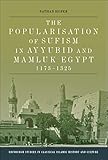The Popularisation of Sufism in Ayyubid and Mamluk Egypt, 1173-1325 / Nathan Hofer.
Material type: TextSeries: Edinburgh Studies in Classical Islamic History and CulturePublisher: Edinburgh : Edinburgh University Press, [2022]Copyright date: ©2015Description: 1 online resource (320 p.)Content type:
TextSeries: Edinburgh Studies in Classical Islamic History and CulturePublisher: Edinburgh : Edinburgh University Press, [2022]Copyright date: ©2015Description: 1 online resource (320 p.)Content type: - 9780748694228
- 297.409620902
- online - DeGruyter
| Item type | Current library | Call number | URL | Status | Notes | Barcode | |
|---|---|---|---|---|---|---|---|
 eBook
eBook
|
Biblioteca "Angelicum" Pont. Univ. S.Tommaso d'Aquino Nuvola online | online - DeGruyter (Browse shelf(Opens below)) | Online access | Not for loan (Accesso limitato) | Accesso per gli utenti autorizzati / Access for authorized users | (dgr)9780748694228 |
Frontmatter -- Contents -- Acknowledgements -- Introduction -- PART ONE State-sponsored Sufism: The Sufis of the Khānqāh Saʿīd al-Su ʿadāʾ -- 1 The Khānqāh -- 2 The Sufis of the Khānqāh -- 3 What is Popular about the Khānqāh? -- PART TWO State-sanctioned Sufism: The Nascent Shādhilīya -- 4 The Emergence of the Shādhilīya in Egypt -- 5 Al-Iskandarī's Image of the Shādhilī Tarīqa -- 6 The Popularisation of Shādhilī Sufism -- PART THREE Unruly Sufism: The Sufis of Upper Egypt -- 7 The Regional Context of Upper-Egyptian Sufism -- 8 Sufi Activists and Enforcers -- 9 Wonder-working Sufis -- Concluding Remarks -- Works Cited -- Index
restricted access online access with authorization star
http://purl.org/coar/access_right/c_16ec
A social, political and religious history of Sufism in Medieval EgyptAfter the fall of the Fatimid Empire in 1171 and the emergence of a new Sunni polity under the Ayyubids, Sufism came to extraordinary prominence in Egypt. The state founded and funded hospices to attract foreign Sufis to Egypt; local charismatic Sufi masters appeared throughout Upper and Lower Egypt; organised Sufi brotherhoods emerged in the urban centres of Cairo and Alexandria; and even Jews took up the doctrines and practices of the Sufis. By the middle of the Mamluk period in the 14th century, Sufism had become massively popular. How and why did this popularisation happen? This book is the first to address this issue directly, surveying the social formation and histories of several different Sufi collectivities from this period. Arguing that the popularisation of Sufism during this time was the direct result of deliberate and variegated Sufi programs of outreach, strategies of legitimation and performances of authority across Egypt, these programs, strategies and performances are situated within the social and political contexts of the institutionalisation of Sufism, audience participation, and Ayyubid and Mamluk state policies.Key FeaturesOffers a wide-ranging description of the variegated social landscape of Sufism in Ayyubid and early Mamluk EgyptPresents a new theoretical model to describe the institutionalisation and popularisation of SufismCase studies of three different groups of Sufis in medieval Egypt track this institutionalisation and popularisationA heuristic framework connects Sufism to larger social and political trends in medieval Egypt
Mode of access: Internet via World Wide Web.
In English.
Description based on online resource; title from PDF title page (publisher's Web site, viewed 24. Mai 2022)


